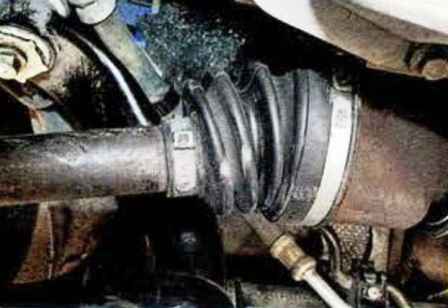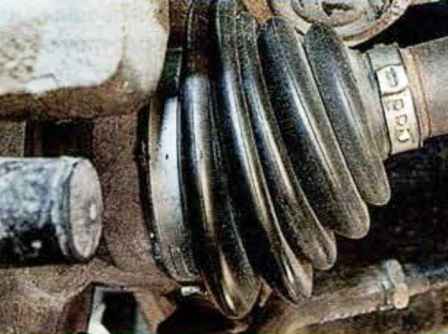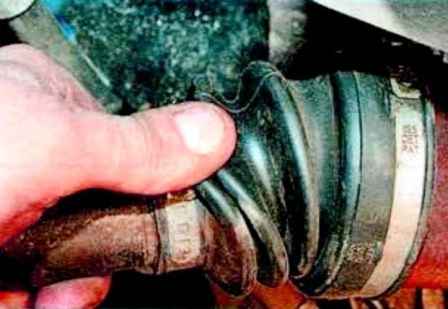The front wheel drives consist of external and internal constant velocity joints (CV joints) connected by shafts
The external hinge allows only angular movements of the connected shafts

The internal hinge makes it possible, in addition to the angular ones, to make axial displacements of the shafts when the front wheels are turned and the suspension is working.
Berfield-type external joint consists of a body, cage, cage and six balls.
Grooves for accommodating balls are made in the hinge body and in the cage.
The grooves in the longitudinal plane are located along the radius, which provides the required angle of rotation of the outer hinge.
The splined tip of the outer joint housing is installed in the front wheel hub and attached to it with a bolt.
The cage of the outer joint is mounted on the splines of the shaft and fixed on the shaft with a retaining ring.
Internal hinge type Tripod consists of a body and three rollers on needle bearings, put on the trunnions of a three-spike hub
Slots for rollers are made in the hinge body.
The three-stud hub is fixed on the shaft with a retaining ring, the rollers allow the hub to move in the grooves of the hinge body in the axial direction, so that the drive can be lengthened or shortened to compensate for the mutual movements of the suspension and the power unit
The splined tip of the internal drive joint housing (A) of the left front wheel is fixed in the side gear of the differential with a spring lock ring, and the splined tip of the drive internal joint housing (B) of the right front wheel is installed in the side gear without fixation, since the housing is fixed from the axial movement by an intermediate support on the engine, the bearing of which is pressed onto the intermediate shaft 4, made in one piece with the body of the internal hinge.
The balls of the same sorting group are installed in the outer hinge. All parts of the hinge are selectively matched to each other, so it is impossible to repair the hinge by replacing individual parts
Only the hinge assembly and a small repair kit are supplied as spare parts, including a retaining ring, boot, boot clamps and in some cases grease.
The inner hinge is supplied as spare parts in the form of two repair kits: a large one, which includes all the hinge parts, and a small one, similar to the outer hinge repair kit.
For the lubrication of hinges, a special lubricant with molybdenum disulfide is used (domestic analogue - SHRUS-4).
The cavities of all hinges are protected from road dirt and water by rubber corrugated covers fixed on the hinge bodies and on the drive shafts, respectively, with large and small clamps.
To ensure the stability of the car and improve its handling when driving at high speed, the left and right wheel drive shafts are made of the same length, and the layout feature of the car’s engine compartment with a transverse power unit (the main gear is shifted to the left relative to the longitudinal axis of the car) is compensated by installing an intermediate shaft, made in one piece with the body of the inner joint of the drive of the right front wheel.
Therefore, the drives of the right and left wheels are not interchangeable. The CV joints of both drives are the same.
The drive hinges are very durable, their design life is almost equal to that of a car. In operation, they are changed or repaired quite often due to damage to protective covers.
This kind of work is expensive and time-consuming. In order to save a lot of money, regularly check the condition of the protective covers of the hinges and replace them immediately in case of the slightest damage.
If water or dust gets into the hinge through a damaged cover, it will fail after several hundred kilometers. Sealed hinge wears extremely slowly
Checking the protective covers of the front wheel drives
The drive hinges are very durable. If the protective covers are damaged, water and dirt enter the hinges, as a result of which they quickly fail
The work of replacing the front wheel drives is quite laborious, and the drives are not cheap.
In order to seriously save your time and money, avoid damage to the protective covers of the hinges (for example, due to a collision with a wire sticking out of the ground) and it replace them slowly at the slightest damage.
If water or dust gets into the hinge through a damaged cover, it will fail after several hundred kilometers
Install the car on a viewing ditch or overpass


Inspect the protective covers of the left inner and left outer hinges

There should be no cracks or tears on the covers. Replace damaged covers.
Similarly inspect the protective covers of the right wheel drive hinges.
Check the tightness of the straps of the cover and the reliability of the fastening of the clamps.
The cover must not rotate on the hinge, and the clamps on the cover. Otherwise, replace the clamps
Possible malfunctions of the front wheel drives and solutions
Vibrations while driving
- heavy wear of the outer joint of the wheel drive
Replace worn hinge
- deformation of the wheel drive shaft
Replace hinge assembly
- wear of the rollers of the inner joint of the wheel drive
Replace inner hinge
- loosening the hub nut
Tighten or replace the nut
Moving the car to the side
- wear or damage to the inner hinge cage
Replace hinge
- wear or damage to the outer hinge
Replace hinge
- damage or deformation of the wheel drive shaft
Replace shaft
- loosening the hub drive nut
Tighten or replace the nut
Grease flowing out of the joint
- wear or tear of the protective cover of the inner or outer hinge
Inspect the hinge, replace if there is any play. Replace damaged cover and lubricant
- insufficient tightening of clamps
Replace and securely tighten clamps
Noise, knock from the front wheel when the car is moving
- damage or deformation of the wheel drive shaft
Replace shaft
- runout of the front wheel drive shaft
Replace shaft
- wear of the rollers of the inner joint of the wheel drive
Replace inner hinge
- loosening the wheel hub nut
Tighten or replace the nut
Knock when turning car
- heavy wear of the outer joint of the wheel drive
Replace hinge





